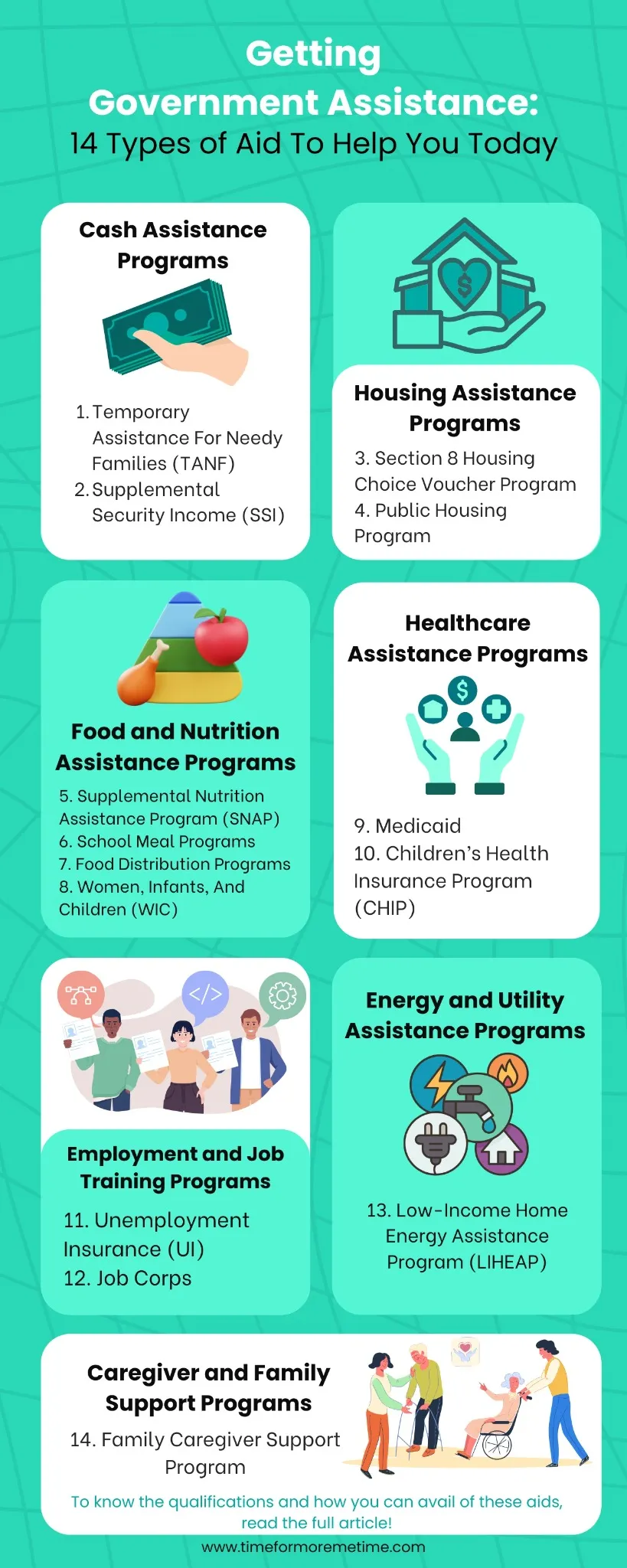
I’ve seen more times than I can count how getting government assistance can be a lifeline for families overwhelmed by the emotional and financial strain of life-altering events.
Whether it’s a serious illness like cancer, a devastating accident, or the mounting costs of caregiving, these challenges can push even the strongest among us to the edge.
As a dosimetrist, I work closely with patients who are facing some of the toughest battles of their lives. I’ve witnessed parents fighting desperately for their child’s health while worrying about how to keep food on the table.
I’ve seen caregivers for elderly parents quietly struggle to make ends meet. It’s heartbreaking, and it’s a constant reminder of how vulnerable any of us can be when life throws us an unexpected curveball.
In moments like these, I always think about the importance of seeking help—not just from friends or family, but from the resources that exist specifically for these situations: government assistance programs.
It doesn’t matter where you live or what your political beliefs are. If you meet the qualifications for assistance, these programs are designed to help.
While it may not always be perfect or immediate, the support can make a real difference when you’re at your lowest.
If you’ve been following my writing, you’ve probably noticed that I often reflect on the most uplifting modernities like these that were far less available when I was a kid.
Back then, if your family was struggling, you faced the real possibility of losing your children to the system. I know because I experienced it firsthand.

Today, the landscape is different. The availability of government assistance has grown, providing families with options that didn’t exist before.
People today are fortunate in ways they may not realize.
While some may criticize programs like these, there’s no denying the impact they have on helping people rebuild their lives. These programs aren’t about handouts; they’re about giving people a fighting chance when they need it most.
At the end of the day, these resources exist for a reason. They are a crucial lifeline for those who find themselves overwhelmed by hardship.
If there’s one thing I’ve learned through my work and my own experiences, it’s this: you don’t have to face these struggles alone. Help is available, and it’s okay to reach out and take it.
Federal assistance programs exist for a simple and essential reason: to support citizens in times of need. These programs are funded through taxpayer contributions, ensuring that resources are available for those facing unexpected challenges.
Whether it’s healthcare support, housing assistance, or financial aid, these programs are not gifts—they’re investments we collectively make to create a safety net for ourselves and our communities.
Using these resources isn’t about dependency; it’s about reclaiming stability when life becomes unmanageable. Hardship can strike anyone, and seeking assistance is a responsible step toward rebuilding a secure and productive future.
That said, some people hold the belief—often rooted in libertarian values—that help should only be sought as a last resort.
While the intent behind this perspective might be self-reliance, it can unintentionally prevent people from accessing support when they need it most. Waiting too long to seek help can worsen problems, leading to greater stress and more severe consequences.
It’s also vital to address the stigma surrounding government assistance.
Many individuals hesitate to apply because they feel embarrassed or worried about being judged. But the truth is, prioritizing your well-being and the well-being of your family is far more important than any misconceptions others might have.
Ultimately, these programs are there for everyone, and using them when you need support is both practical and justified. Overcoming the stigma and understanding the true purpose of government assistance can make all the difference in navigating life’s toughest moments.
With these out of the way, what are the key federal assistant programs you can take advantage of?
1. Temporary Assistance For Needy Families (TANF)

TANF provides temporary financial support to low-income families to help cover essential needs such as food, housing, and utilities. However, its main goal is to promote long-term self-sufficiency.
The program requires recipients to participate in job-related activities, including job training, job searches, or community service. These efforts are designed to help individuals develop the skills and resources needed to become self-reliant.
However, TANF is intended to be a short-term solution, with most families limited to receiving assistance for a total of 60 months.
In addition to financial support, TANF often offers supplementary services such as childcare assistance, transportation vouchers, and career counseling to help recipients transition into the workforce.
Since TANF is administered at the state level, eligibility and benefits can vary, so individuals must apply through their state’s Department of Human Services.
2. Supplemental Security Income (SSI)
SSI is a federal program that offers financial assistance to individuals who are unable to work due to age, disability, or other significant barriers.
Designed to meet basic living expenses, SSI provides monthly payments to individuals with limited income and resources. This mainly helps cover essentials like food, shelter, and medical costs.
Eligibility is available to individuals aged 65 or older, as well as to blind individuals and those with disabilities, including children, who meet strict financial criteria. In most states, SSI recipients also automatically qualify for Medicaid, which provides free or low-cost healthcare services.
However, unlike Social Security, SSI is funded through general tax revenues, not payroll taxes, meaning eligibility is not tied to a person’s work history. Applications for SSI can be made through the Social Security Administration, either online, by phone, or in person at a local SSA office.
3. Section 8 Housing Choice Voucher Program

The Section 8 Housing Choice Voucher Program helps low-income families, seniors, and individuals with disabilities secure affordable housing in the private rental market.
Unlike traditional public housing, Section 8 vouchers allow participants the flexibility to choose their own homes as long as they meet safety and quality standards.
This flexibility can include renting apartments, houses, or even townhomes. Rent subsidies are provided, with recipients typically paying about 30% of their income toward rent, while the voucher covers the rest, paid directly to the landlord.
Eligibility is based on income limits set by the U.S. Department of Housing and Urban Development (HUD), with priority given to vulnerable groups such as families with children, elderly individuals, and people with disabilities.
Section 8 vouchers are also portable, meaning recipients can move to another city or state while continuing to receive housing assistance as long as they meet the program’s requirements.
Due to high demand, individuals must apply through their local public housing authority (PHA), where there may be a waiting list.
4. Public Housing Program
The Public Housing Program offers affordable housing directly managed by local public housing authorities (PHAs).
Unlike the Section 8 program, which provides rental subsidies, public housing involves government-owned properties that are maintained and operated to provide safe and stable living environments for low-income individuals and families.
Rent is typically calculated based on a household’s income, usually around 30% of their adjusted gross income, ensuring affordability for those with limited financial resources.
The housing options available vary depending on location and household size, including apartments, townhouses, and single-family homes.
Meanwhile, eligibility is based on income guidelines, citizenship or eligible immigration status, and other criteria set by HUD and local PHAs. Many public housing communities also offer additional services such as childcare, job training, and community activities to help residents achieve self-sufficiency.
Do note that applications for public housing must be submitted directly to local PHAs, where waitlists are common due to high demand.
5. Supplemental Nutrition Assistance Program (SNAP)

SNAP, formerly known as the Food Stamp Program, is a vital federal initiative to reduce food insecurity among low-income individuals and families. Managed by the U.S. Department of Agriculture (USDA), it helps millions of Americans afford groceries and maintain a nutritious diet.
Benefits are distributed through an Electronic Benefit Transfer (EBT) card, which works like a debit card and can be used at grocery stores, supermarkets, and some farmers’ markets to purchase approved food items.
SNAP encourages the purchase of healthy foods, including fruits, vegetables, dairy products, and proteins. However, it strictly excludes non-nutritious items such as alcohol, tobacco, and hot prepared foods.
A person’s eligibility is based on household income, size, and expenses, with most applicants required to have a gross income at or below 130% of the federal poverty line.
Additionally, some states pair SNAP benefits with nutrition education to help recipients make healthier food choices.
Individuals can apply online, by mail, or in person at local social services offices. Unlike other government assistance programs, SNAP’s benefits are reviewed periodically to ensure continued eligibility.
6. School Meal Programs
The National School Lunch Program (NSLP) and the School Breakfast Program (SBP) provide free or reduced-cost meals to children from low-income households.
Its goal is to ensure children receive the nutrition necessary for academic and physical success.
Just like most programs here, eligibility is based on household income. Primarily, children from families earning at or below 130% of the federal poverty line qualify for free meals, while those earning between 130% and 185% qualify for reduced-cost meals.
However, the kids can’t just eat whatever. The meals served must meet USDA nutrition standards, including balanced portions of fruits, vegetables, grains, proteins, and dairy.
School meal programs are available in most public and nonprofit private schools, as well as some child care institutions.
But what happens during summer break when there’s no school? To prevent food insecurity for kids, the Summer Food Service Program provides meals to children in low-income areas during the summer months.
Parents or guardians can apply for school meal programs through their child’s school, with many schools incorporating applications into their enrollment process or distributing forms at the beginning of the school year.
7. Food Distribution Programs

Aside from children, the federal government has developed multiple programs to give food to low-income families, seniors, and minorities. Federal food distribution programs aim to provide eligible families with direct access to nutritious foods.
- The Emergency Food Assistance Program (TEFAP) distributes USDA-purchased foods to food banks, pantries, and soup kitchens, which in turn offer free food to low-income families.
- The Commodity Supplemental Food Program (CSFP) targets low-income seniors aged 60 and older, providing monthly food packages that include items like cereals, canned fruits and vegetables, and proteins.
- The Food Distribution Program on Indian Reservations (FDPIR) serves low-income Native American families living on or near reservations, providing USDA-purchased foods as an alternative to SNAP benefits.
TEFAP and CSFP foods are typically distributed through local food banks and community organizations, while FDPIR benefits are provided through tribal organizations or state agencies.
Eligible individuals can apply directly through the administering body in their community.
8. Medicaid
I’m sure you’ve already heard of Medicaid. It’s a significant federal program that provides free or low-cost healthcare to low-income individuals, families, pregnant women, seniors, and people with disabilities.
The program is jointly funded by the federal government and individual states. Despite being a government program, Medicaid offers comprehensive healthcare services, including doctor visits, hospital stays, prescription medications, preventive care, mental health services, and long-term care.
Do note that some states also provide additional benefits, such as dental and vision care.
The criteria for eligibility primarily depends on income and household size, with priority given to specific groups like children, seniors, and individuals with disabilities.
Some states have expanded Medicaid under the Affordable Care Act (ACA) to cover more adults.
For most recipients, Medicaid involves little to no out-of-pocket costs, although costs may vary by state and service.
To apply, individuals can contact their state Medicaid office or use the Health Insurance Marketplace, with applications requiring proof of income, residency, and household size.
9. Children’s Health Insurance Program (CHIP)

In the hospital setting, you’ll see CHIP being utilized a lot. The Children’s Health Insurance Program provides health coverage for children in families who earn too much to qualify for Medicaid but cannot afford private insurance.
CHIP ensures that children from low- and middle-income families have access to essential healthcare services. The program covers routine check-ups, vaccinations, dental care, vision care, emergency services, and mental health care.
Fortunately, in some states, CHIP also covers pregnant women. Most families pay little to no premiums, while those with higher incomes may have modest premiums and copayments.
To get CHIP, families can contact their state Medicaid office or use the Health Insurance Marketplace. Enrollment is open year-round, making it easier to secure coverage when needed.
10. Family Caregiver Support Program
If you’re caring for your parents or any seniors or person with disabilities (PWDs) as their primary caregiver, you can avail the Family Caregiver Support Program. It offers assistance to those caring for elderly parents or individuals with disabilities, recognizing the physical, emotional, and financial challenges caregivers face.
The program provides respite care, allowing caregivers to take temporary breaks from their responsibilities, reducing stress and preventing burnout. It also offers counseling services and support groups to address emotional needs.
In some cases, it provides training and resources to help caregivers manage complex care, such as for individuals with dementia or disabilities. While in select cases, caregivers may receive financial assistance for home care or transportation to medical appointments.
Eligibility and services may vary by state, and caregivers can contact their local Area Agency on Aging or the Department of Health and Human Services for more information.
11. Unemployment Insurance (UI)

I have a few friends who got into Unemployment Insurance (UI). It basically provides temporary financial assistance to individuals who lose their jobs through no fault of their own, helping them stay financially stable while they search for new employment.
This program offers a weekly stipend to eligible individuals to cover basic living expenses. To qualify, individuals must have worked a certain number of weeks or earned specific wages in their previous employment.
Also, it’s critical that they be actively seeking work and available to take a new job.
During economic crises or high unemployment periods, such as the COVID-19 pandemic, the federal government may extend benefits or increase payment amounts.
UI applications can be submitted through state unemployment offices, either online or by phone, with eligibility requirements varying by state.
12. Job Corps
I think I’ve already talked about apprenticeship programs in one of my articles, and a good alternative to that is the Job Corps.
It’s a free program that provides education and vocational training for young adults ages 16 to 24, helping them develop skills for the workforce. It also offers apprenticeship programs with its partners.
Anyway, participants can earn a high school diploma or GED while gaining industry-recognized certifications in fields like healthcare, construction, and information technology.
Job Corps offers free housing and meals at its residential centers, as well as transportation assistance for eligible students.
The program also includes job readiness training, career counseling, job placement assistance, and mentorship to support participants in their personal and professional growth.
To get into this, apply online or at local Job Corps centers, where eligibility is determined through an intake process.
Or you can apply to online jobs for students if you want to work from anywhere.
13. Low-Income Home Energy Assistance Program (LIHEAP)

For those who live in states with extreme temperature drops and rises, the Low-Income Home Energy Assistance Program (LIHEAP) helps them out with their heating and cooling.
It helps low-income households afford home heating and cooling costs, especially during extreme weather conditions.
The program provides direct payments to utility companies to reduce heating and cooling costs. In the event of energy-related crises—like power outages or heating failures—LIHEAP offers emergency assistance to restore services.
It also supports weatherization efforts to improve home insulation, seal windows, and doors, and upgrade heating systems. These help reduce energy costs long term.
Requirements and application procedures vary by state. To apply, go through local LIHEAP offices or community action agencies.
14. Women, Infants, And Children (WIC)
And last on the list, the Women, Infants, and Children (WIC) program. It offers nutrition education, supplemental food, and healthcare referrals to pregnant women, new mothers, and children under five.
WIC ensures vulnerable populations receive nutritional support during critical stages of development. The program provides nutritious foods, including fruits, vegetables, whole grains, dairy products, and infant formula.
Participants also receive health and nutrition education on topics like healthy eating, breastfeeding, and child development. They also get easy access to lactation consultants and breastfeeding supplies.
Plus, this program also connects participants to healthcare services, immunizations, and family planning resources. Depending on income and nutritional risk, you may be eligible.
To get more information, visit your local WIC offices or community health centers.
FAQs
Need more information? Here’s the FAQ section to help!
Can I apply for multiple government assistance programs at once?
Yes, many individuals may qualify for multiple programs, depending on their circumstances. Each program has its own eligibility requirements, so it’s important to apply for those that best match your needs.
Is getting government assistance programs available to undocumented immigrants?
Most federal assistance programs require applicants to be U.S. citizens or legal residents. However, some states offer limited state-funded assistance to undocumented immigrants.
Can I still apply for government assistance if I don’t have a permanent address?
Many programs, such as SNAP and Medicaid, allow individuals without a permanent address to apply. In these cases, applicants can use a shelter or a family member’s address for correspondence.
Conclusion
Looking back on my experiences, I’ve seen firsthand how government assistance programs can truly change lives. I’ve watched families overwhelmed by financial struggles and emotional stress find hope and stability after accessing the right resources.
These programs have helped me personally during some of my hardest times, and I want to share that there is no shame in seeking help. If you have a friend who is struggling, encourage them to learn about these programs.
Offer to help them apply or even drive them to the office if they need it. Sometimes, just a little support can make all the difference.
If you or someone you know is facing tough times, please remember that help is available. I encourage you to explore the many resources designed to support you.
Government assistance programs are there for a reason—to offer help when life gets difficult.
Don’t wait until things get out of hand. Reach out and take advantage of the support that’s available. Taking that first step can change everything for the better.
Explore more ways to increase your income, save money, and make the most of your time by visiting our blog and subscribing to our YouTube channel for practical tips and strategies!
Sources
- Photo: Unsplash: Joel Muniz






